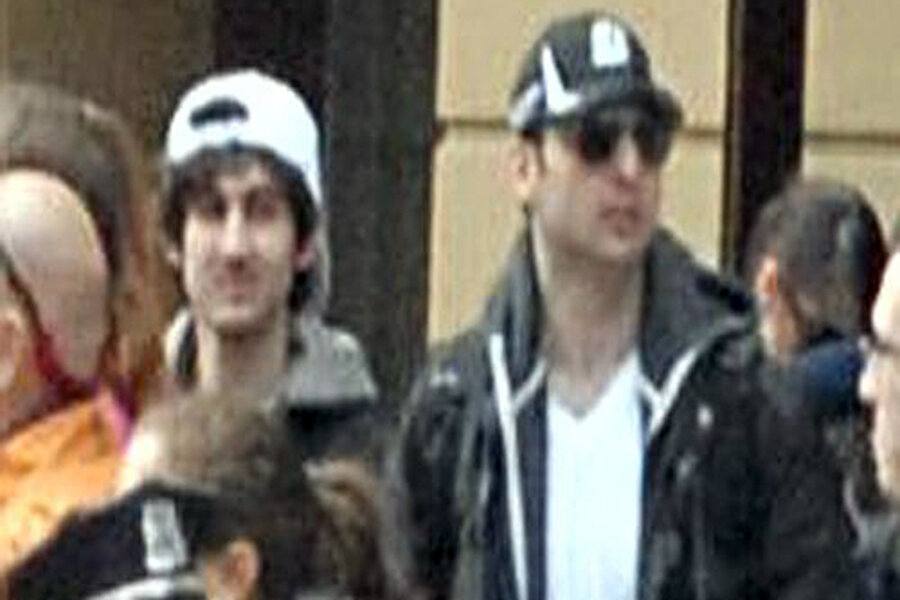Were motives of Boston bombing suspects embedded in Chechen heritage – or not?
Loading...
| Washington
Identification of the two principal suspects in the Boston Marathon bombings as two immigrant Chechen brothers who grew up in and around the heavily Muslim Caucasus region of Russia during a particularly violent period would seem to add a clarifying element to the already astounding events in Boston this week.
Evidence that the older of the two brothers had recently expressed increasingly jihadist thinking on social media sites adds a radical Islamist element to the mix.
But a picture is emerging of two young men who were, mostly, increasingly disaffected with their adopted home. It could be they were searching to assert an identity from the religious and political elements of a rootless and violence-marked upbringing, some terrorism and Central Asia experts say.
At least one relative, an uncle living in the US, told a Boston TV station Friday that the brothers were “losers” who were angry at others who were making it in America. “Anything to do with a religion is a fraud,” the uncle, Ruslan Tsarni, told Boston’s Channel 7 News, adding that the brothers had been unable to settle down and get ahead, and were angry about that.
However the young men’s roots in a violent region can’t be dismissed, some experts say.
“Chechnya has a very brutal history. You can just imagine two young Chechen boys growing up [in that violence] and then being dropped in the United States,” says Fiona Hill, an expert in Russia and its regional conflicts at the Brookings Institution in Washington. Noting how that could be “incredibly disorienting,” she adds, “And here they are in their 20s, a classic time for people to search for identity.”
Tamerlan Tsarnaev, 26, the older brother shown wearing a dark cap in FBI photos released Thursday, appears to have posted religious videos that included references to the liberation of the Muslim regions of Central Asia before the bombings Monday and the shoot-out in Watertown early Friday in Boston where he was fatally wounded.
His younger brother, Dzhokar Tsarnaev, 19, the suspect shown wearing a white cap in FBI photos, was born in Kyrgyzstan but appears to have kept a page on a Russian social network where he identifies as Muslim and expresses interest in events in Chechnya, the predominantly Muslim Russian province where Russian authorities fought two ruthless wars in the 1990s and 2000s as separatists battled central Russian rule.
All of these elements could suggest that the Tsarnaev brothers carried out the marathon bombings as a result of some link to a foreign terrorist organization. But the more likely scenario, some experts say, is that the two immigrants were “lone wolves” perhaps inspired by a radical foreign ideology but acting more in a quest to assert an identity.
“These are not Chechen rebels, this is not a Chechen operation,” says Mark Ensalaco, a terrorism expert at the University of Dayton. “My hypothesis would be that these were lone wolves who may have been inspired by jihadist ideology, but who were acting more for psychological reasons and gravitated towards a radical ideology as they sought to overcome their disaffection [with their adopted land] by asserting a sense of identity.”
The two brothers are thought to have come to the United States in 2002, by way of Turkey. They have relatives on the US East Coast, but their father lives in Makhachkala, the capital of Dagestan – one of the more radicalized regions of the Caucasus.
In one social media post, the older brother, Tamerlan, claims not to have “a single American friend” and says of Americans “I don’t understand them.” Yet the boxer who competed for New England in the 2010 National Golden Gloves competition is identified in a picture caption as dreaming of participating in the Olympics and preferring to “compete for the United States [rather] than for Russia.…Unless his native Chechnya becomes independent.”
While the younger brother was a naturalized US citizen, Tamerlan was a legal immigrant with a Green Card work permit.
Brookings’ Ms. Hill says the brothers may have ended up in Boston because the city has a sizable immigrant population from the Caucasus. But she adds that they were likely marked by a violent past.
“Their whole experience has been one of their people basically being persecuted, killed, maimed,” she theorizes. She says that Dagestan (where their father lives and where they seem to have spent some years) “has become one of the most radical places in Russia now, because there is just so much disaffection, both with the local government and with the central Russian government.”
Yet the picture emerging is more one of two brothers – perhaps where the older, more disaffected brother is influencing his younger sibling – who are lashing out as a means of asserting an identity, Dayton’s Mr. Ensalaco says.
“There is no evidence at this point that these young men received any type of foreign radical training, but there does seem to be strong evidence of a radicalization through social media and contact with radical websites,” he says, noting that Tamerlan appears to have visited sites including some affiliated with Al Qaeda.
Looking back over past decades, Ensalaco says there are famous cases of “lone wolf” terrorists who “latched on” to a cause or ideology as a pretext for carrying out their violent acts.
“I’d say these guys were identifying with this cause [jihadism] for psychological reasons,” he says, “but from what we’ve seen so far, any indoctrination they received came online” and may indeed have been one way – one or both men visiting websites but not necessarily contacting anyone at the other end.
“Their bombs weren’t very sophisticated, and they don’t seem to have had any escape plan,” Ensalaco says. “That doesn’t suggest any degree of training.”
Staff writer Stacy Teicher Khadaroo contributed to this report.







